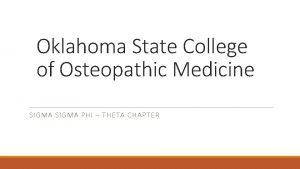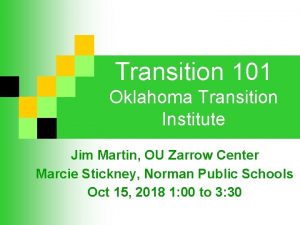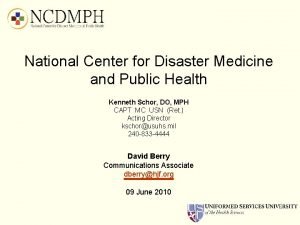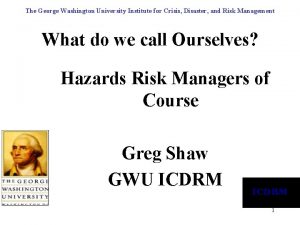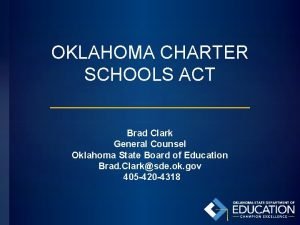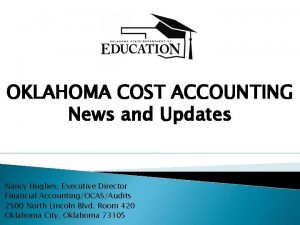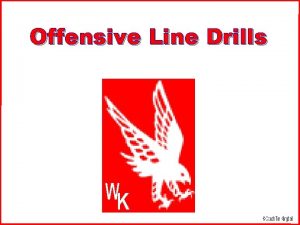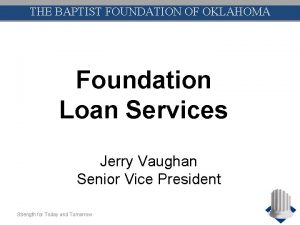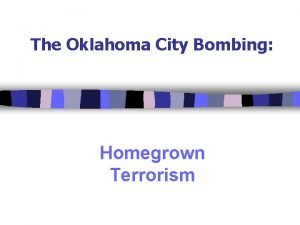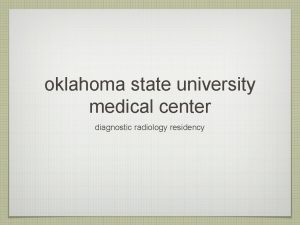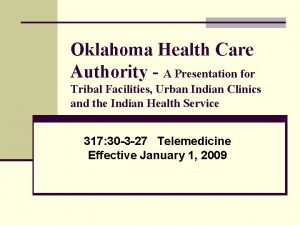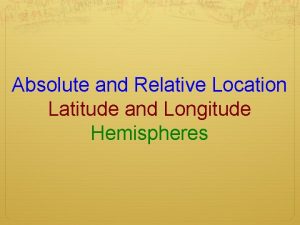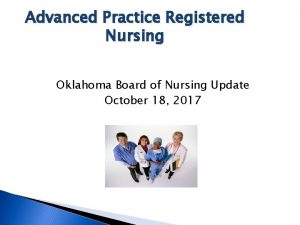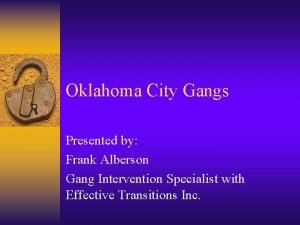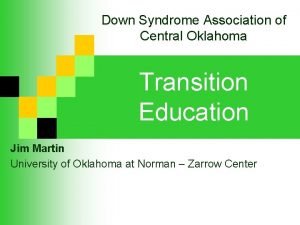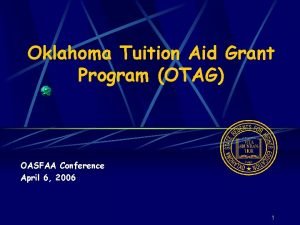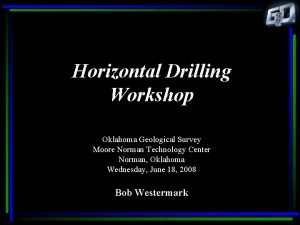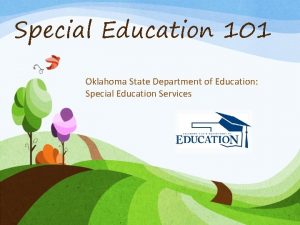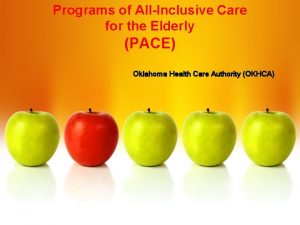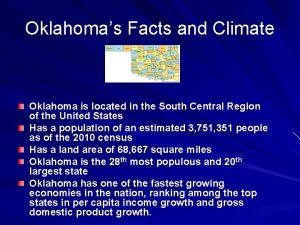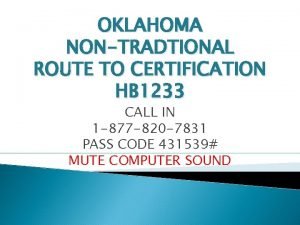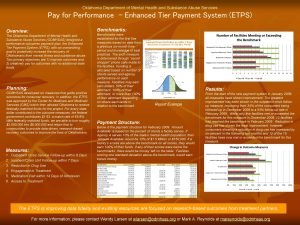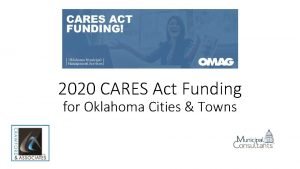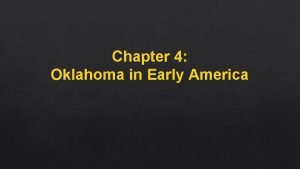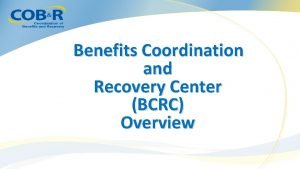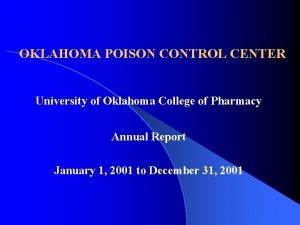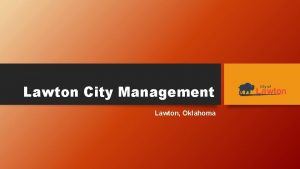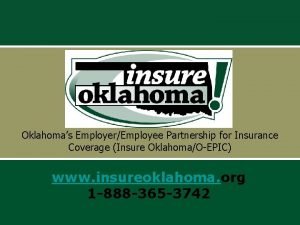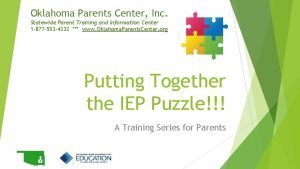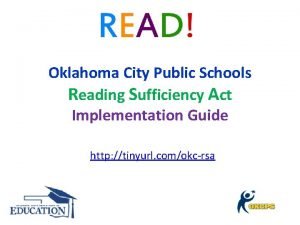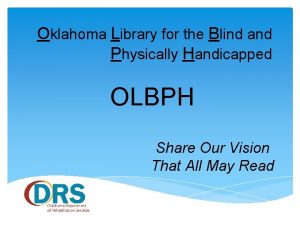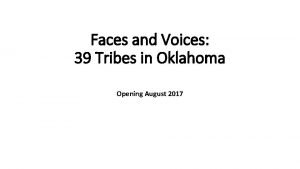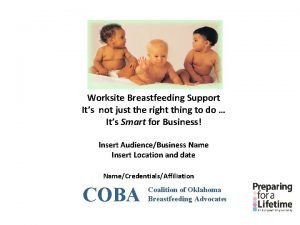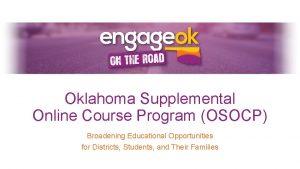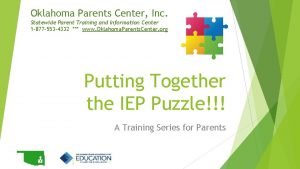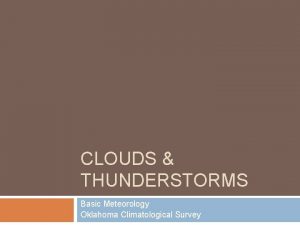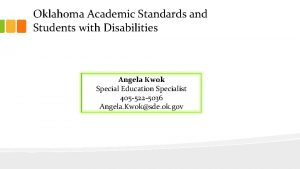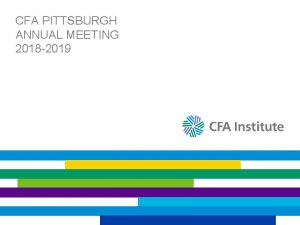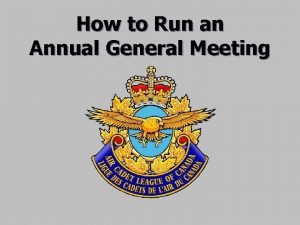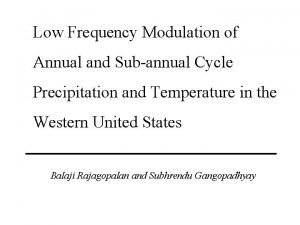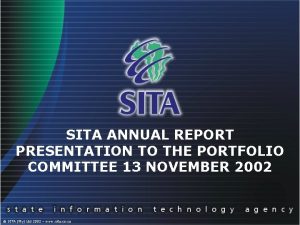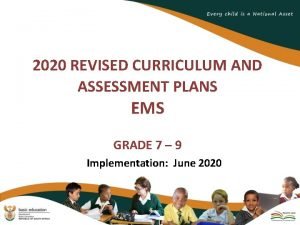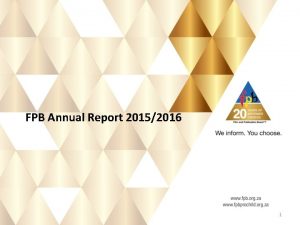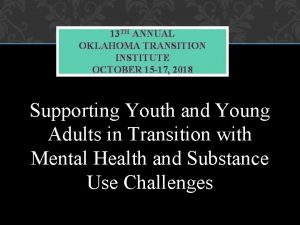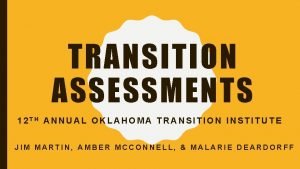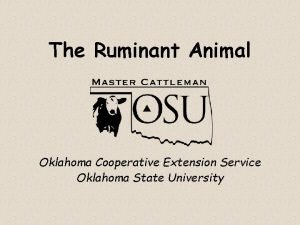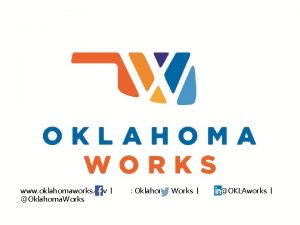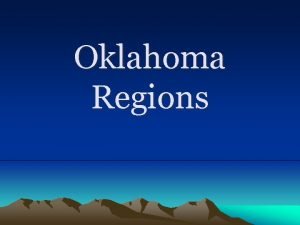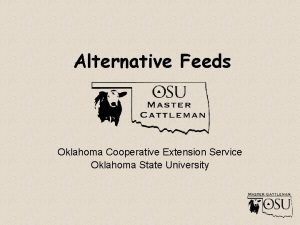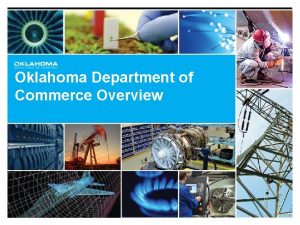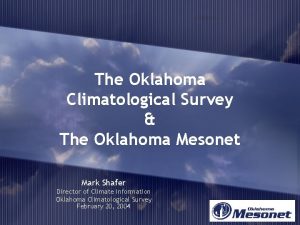OKLAHOMA DISASTER INSTITUTE 3 RD ANNUAL DISASTER MEDICINE





















































































- Slides: 85

OKLAHOMA DISASTER INSTITUTE 3 RD ANNUAL DISASTER MEDICINE SYMPOSIUM Austere Medicine What to do when the lights go out Joseph J. Contiguglia MD, MPH&TM, MBA Clinical Professor of Public Health Tulane University School of Public Health & Tropical Medicine

DISASTER

OVERVIEW w. Threats & Vulnerability w. Readiness w. Response w. Recovery w. Management

VULNERABILITY w Population w Lifestyle w Emerging Disease w Environment w Technology w Political Strife

DISASTER w Emergency – Realignment of priorities – Change of process & guidelines – Redefined standards for outcomes w Disaster – Local Resources Inadequate – Modified standards achievable w Catastrophe – Adequate resources unavailable – Fight to maintain orderly application of assets

INTERVENTION PRINCIPLES w w Keep the Science Straight Realistically evaluate threats & assets Rationally develop specific plans Identify needs: – – – LIFESAVER EXERCISES Doctrine “THAT OTHERS MAY LIVE” Organization Communications Equipment Personnel & Training w Speak with one voice

GLOBAL POPULATION GROWTH w Overall – Today – 6. 8 B – 2040 – 9 B http: //www. census. gov/ w Urban – 1800 – 3% – 2000 – 47%

LIFE EXPECTANCY w US – Male – Female Today 1950 1900 75. 6 80. 8 65. 5 71. 0 47. 9 51. 7 U. S. BUREAU OF THE CENSUS

SPECIAL NEEDS w. Age w. Disability w. Medical w. Acute Injury w. Psychological w. Culture & Lifestyle

WORLD HUNGER w Poverty w Economic Systems w Conflict w Climate w But the world produces enough food – 2720 kcal/person/day UNITED NATIONS FOOD AND AGRICULTURE ORGANIZATION OCT 14, 2009

WATER w. Hierarchy of needs w. WHO CHOLERA, 1883 THE UNWELCOME VISITOR – 78 percent of the population in less developed countries is without clean water – 85 percent without adequate fecal waste disposal

PREMATURE VICTORY Don’t worry, it’s only a w 1967 virus “the war against infectious diseases had been won” and we should focus our efforts on other areas of research and public health… – Surgeon General William H. Stewart testifying before Congress

EMERGING INFECTIOUS DISEASE w 75% of emerging infectious diseases reach humans through animals w 49% of human pathogens are zoonotic

THE BLACK DEATH: 1346 AD w Lasted more than 130 years w Killed 20 -30 million Europeans – (1/3 of the European population) w Probably began on the Mongolian steppes as an epidemic among marmots – Weather favored a rodent population explosion w Trappers collected furs of dead animals & sold them to Western buyers

AMERICA & THE COLUMBIAN EXCHANGE w Smallpox & Measles w New diseases in non-immune populations w 95% mortality w “The gods are against us”

GLOBAL ENERGY

THE RADIOLOGICAL THREAT THREE MILE ISLAND w. Nuclear Warfare w. Nuclear Terrorism w. Nuclear Accidents

ACTION PHASES READINESS w 1. Prevention w 2. Preparation w 3. Surveillance w 4. Identification

PREVENTION w Shape the Battlefield w Psychological Injury Management w Communications Infrastructure w Risk Communication w Education – – Government Officials Community Leaders Responders Population at Large

CONCEPT OF OPERATIONS (CONOPS) w. Effective w. Practical w. Robust w. Authorized – Incorporated in law, plans & regulations

OPERATIONAL MODEL AEROSOL CONTAGEOUS VIRAL EXPOSURE WIND MASS COMMUNICATIONS X FACILITY TREATMENT & SCREENING ESTIMATED EXPOSURE ZONE PLACE & TIME POPULATION AT LARGE POPULATION AT RISK POTENTIAL CONTACTS - PRESENT HOSPITAL C FACILITY SPECIALIZED TREATMENT SYMPTOMATIC PATIENTS - TRANSIENT - DOWNWIND HOSPITAL NON HOSPITALIZED EXPOSED INDIVIDUALS EVALUATION & PROPHYLAXIS SITES TREATED ASYMPTOMATIC CONTACTS R FACILITY SUPPORT

GUIDELINES & STANDARDS w Guidelines & Standards are needed to define measurable, acceptable and approved pathways & outcomes for individuals and agencies to pursue during a time of scarce resources.

GUIDELINES & STANDARDS w They permit; – The systemized optimization of alternatives and compromises – Within an ethical context – Upon which public morale and the preservation of civil order depends, as well as – Preparing a resilient and sustainable infrastructure.

OUTCOME w To optimize outcome, all available resources need to be preserved, coordinated and focused so as to optimize community response in dealing with; – 1. The normal ongoing needs of the stricken and spared populations – 2. The special disaster-related needs of the population at risk – 3. The special needs encountered by populations with special vulnerability

PREVENTION w What is the difference between PREVENTION and PREPARATION?

PREVENTION w What is the difference between PREVENTION and PREPARATION? – A. PREVENTION focuses on building a resistant and resilient environment – B. PREPARATION focuses on developing the capability for a coordinated, timely & effective response

PREPARATION w Assets – Personnel • Numbers & Training – Equipment – Logistics & Supplies – Risk Communications w Infrastructure – Authority – Command, Control, Communications & Intelligence

COMMAND

OPERATIONAL COMPONENTS w. Personnel – Adequate numbers for initial & sustained operations – Trained in appropriate skills – Authorized for time/duty required

OPERATIONAL COMPONENTS w Equipment – Available, familiar & ready – Supplies – Time phased logistics w Risk Communications w Prepared Population with social tools in place w Practice & revision for evolving needs

SURVEILLANCE w. Scope w. Sensitivity w. Specificity w. Reliability w. Security w. Cycle Time

IDENTIFICATION w. Specificity w. Confidence w. Immediacy

ACTION PHASES EXECUTION w 5. Notification w 6. Marshalling w 7. Early Response w 8. Full Response w 9. Mop - Up

NOTIFICATION w. Timely – Here is where it begins w. Robust w. Orderly w. Functional

MARSHALLING w “Get There Firstest with the Mostest” w. Right People w. Right Stuff w. Right Time w. Right Place

EARLY RESPONSE w. Effective w. Professional w. Orderly

FULL RESPONSE w. Big as it needs to be to minimize casualties w. Delicate as a battleship

MOP - UP w. Finish it off w. Thorough w. Quick w. Disciplined w. Responsive to the Public – Plans & Actions – Tactical Risk Communication

MEDIA PUBLIC INFORMATION TACTICAL CONSIDERATIONS 1. TARGETED 2. SPECIFIC 3. AUTHORITATIVE 4. CONCISE

ACTION PHASES RECOVERY w 10. Clean Up w 11. Reconstitution w 12. Convalescence/Healing w 13. Rebuilding w 14. Prevention – Shape the Battlefield

CLEAN - UP w. Follow Through w. Hierarchy of needs

FOLLOW THROUGH DO IT RIGHT A- Isolation B- Decontamination C- Interview D- Clinical specimens E- Containment F- Floor sampling G- HVAC sampling H- Outside samples I- Surface sampling

FOLLOW THROUGH w. Return of Personnel & Equipment w. Damages & Reimbursement w. Recognition – Authorities, Agencies & Participants w. Constructive Feedback

HEIRARCHY OF NEEDS KIBEHO REFUGEE CAMP, RUWANDA, 1994 w Safety w Water w Food w Shelter/heat w Clothing w Medical Care w Employment JTF SAFE HAVEN PANAMA 1995

HEIRARCHY OF NEEDS w Companionship w Family envmt. w Stability w Social status & advancement w Child development w Care of elders w Mid & long term plans SCHOOL ART KOSOVO MEETING HUT, EMPIRE RANGE, JTF SAFE HAVEN

RECONSTITUTION w. Ready to go again

CONVALESCENCE / HEALING RETURN OF FUNCTIONS w. Governance w. Housing w. Municipal Services w. Public Health Infrastructure w. Medical Services w. Education Services

EDUCATION w Community Awareness w Citizen Skills w Cooperative Action w Responder Training w Formal Education w University – Pure Science – Applied Science – Social Science

REBUILDING w. For the future not the past

RESOURCES

COORDINATION

PREVENTION DESMOND TUTU w. Shape the Battlefield w. Back to the Future w“The good news to a hungry person is bread. ” – Desmond Tutu

PSYCHOLOGICAL INJURY w. Expect large numbers of casualties w. Treatment principles – Proximity – Immediacy – Expectancy SOLDIERS RESTING ON OMAHA BEACH WAR PSYCHIATRY, ZAJTCHUK

PSYCHOLOGICAL INJURY w. Stress of dealing with casualties – Fatigue • Overworked • Understaffed • Sleep deprivation

CRISIS & CONSEQUENCE MANAGEMENT INTEGRATION CRISIS MANAGEMENT LOCAL INCIDENT COMMAND SYSTEM OR UNIFIED COMMAND SYSTEM CONSEQUENCE MANAGEMENT

CONSEQUENCE MANAGEMENT LOCAL SUPPORT FEMA w Do. D Teams w Weapons of Mass Destruction Civil Support Teams (WMD-CST) w Joint Task Force - Civil Support (JTF-CS) w Metropolitan Medical Strike Teams (MMST) w Federal Emergency Management Agency (FEMA) – State Emergency Management Agencies

THE LEOPARD w“If we want everything to stay the same, it is necessary for everything to change. " – Fabrizio Tomasi, Prince of Salina

FALL BACK RETREAT FROM RICHMOND w Change process to maintain standards of outcome w Deliberate decisions by authorized leadership w Coordinated pullback to maintain new standards – Carefully planned – Capable of support – Personnel trained & equipped w Optimize outcome under evolving conditions http: //www. picturehistory. com/product/id/29344#

ALTERNATIVE STANDARDS OF CARE w Alternative Standards of Care imply the deliberate and planned alteration of a series of elements in the medical care process;

ALTERNATIVE STANDARDS OF CARE w 1. Who – implying variation in roles, competencies and training,

ALTERNATIVE STANDARDS OF CARE w 2. How Provided – implying variation in process

ALTERNATIVE STANDARDS OF CARE w 3. Where Provided – implying variation in sequence and venue

ALTERNATIVE STANDARDS OF CARE w 4. How Overseen – implying variation in level of expertise and clinical sophistication

ALTERNATIVE STANDARDS OF CARE w 5. How Evaluated – implying alteration in criteria of outcome

EVALUATION w Using responsible agencies & appropriate focus groups, metrics should be proposed and employed in defining the shortfall of functional capabilities for outcome, efficiency and coordination.

EVALUATION w 1. Timeliness of response and time sensitivity of outcome

EVALUATION w 2. Access for individuals within vulnerable populations at risk

EVALUATION w 3. Quality of medical intervention and the employment of available technology

EVALUATION w 4. Effectiveness of diagnostic and therapeutic actions in the preservation of life and health

EVALUATION w 5. Acceptability within the expectations and cultural sensitivities of the community

MANAGEMENT w Time Phasing Critical w Decision Points w Defined Options – Pre-approved actions w Prepared – Sites – Operational Elements – Equipment – Supply flow & alternative sourcing – Manning

STOVEPIPE RECOVERY-BASED MANAGEMENT w Primary focus on disaster events w Basic responsibility to respond w Fixed, location-specific conditions w Responsibility in single agency w Command control, directed operations w Established hierarchical relationships – Focused on hardware and equipment w Specialized expertise w Urgent, immediate, and short time frames

BROAD COMMUNITY PLANNING PREVENTION-BASED MANAGEMENT w Focus on vulnerability and risk w Exposure to changing conditions w Changing, shared or regional, variations w Multiple authorities, interests, actors w Situation-specific functions w Shifting, fluid, and tangential relationships w Moderate and long time frames

MEDICAL COMMAND

TOOLS w Horizontal Community Planning – Prevention Model integrated with Recovery Model – Across Responding Agencies w Guidelines – Coordinated & Integrated w Standards – – – Modified Timing Training Outcome Care

w Ethics TOOLS – Substantive elements – Procedural elements – Values w Principles w Professional Codes w Defined Duty Requirements – Compensation & Benefits w Mandate & Sanction

RISK COMMUNICATIONS w. Authorities w. Population of Responders w. Population at Risk w. Population at Large

PANIC AVOIDANCE AS A GOAL w. Many communication plans list the avoidance of panic as a major goal w. Panic describes an intense contagious fear causing individuals to think only of themselves

PANIC AVOIDANCE AS A GOAL w Risk factors for panic include: – The belief that there is only a small chance of escape – The perception that there are no accessible escape routes – Perceiving oneself at high risk of being seriously injured or killed – Available but limited resources for assistance

PANIC AVOIDANCE AS A GOAL w Risk factors for panic include: – Perceptions of a "first come, first served" system – A perceived lack of effective management of the event – A perceived lack of control – Crowd ("mob") psychology and dynamics – Authorities that have lost their credibility

PANIC AVOIDANCE AS A GOAL w Studies indicate that panic is rare w Most people respond cooperatively and adaptively to natural and man-made disasters. w Panic avoidance should never be used as a rationale for false reassurance or for lack of transparency w We create or own heroes

BACK TO THE FUTURE Camp Funston, Kansas “If we don’t deal with these issues now, our children will face them in the future. ”

MAINTAIN SITUATIONAL AWARENESS Bear!

SUMMARY w. Threats & Vulnerability w. Readiness w. Response w. Recovery w. Management GEN GEORGE PATTON w “Plans are Nothing, Planning is Everything. ” – Gen. George A. Patton

QUESTIONS?
 Oklahoma state college of osteopathic medicine
Oklahoma state college of osteopathic medicine Oklahoma transition institute
Oklahoma transition institute National center for disaster medicine and public health
National center for disaster medicine and public health Institute for crisis disaster and risk management
Institute for crisis disaster and risk management Leicester precision medicine institute
Leicester precision medicine institute Martin tobin leicester
Martin tobin leicester Duke translational medicine institute
Duke translational medicine institute Brad clark oklahoma
Brad clark oklahoma Ocas codes oklahoma
Ocas codes oklahoma Are oklahoma drills illegal
Are oklahoma drills illegal Pl focus
Pl focus Oklahoma alternative placement program
Oklahoma alternative placement program Oklahoma abstractors board
Oklahoma abstractors board Oklahoma cooperative extension service
Oklahoma cooperative extension service Oklahoma church renovation financing
Oklahoma church renovation financing What river separates texas and oklahoma?
What river separates texas and oklahoma? Oklahoma lottery education trust fund
Oklahoma lottery education trust fund Oklahoma special education handbook
Oklahoma special education handbook Oklahoma city bombing
Oklahoma city bombing Special education handbook oklahoma
Special education handbook oklahoma Ppl prepaid legal
Ppl prepaid legal Oklahoma state radiology residency
Oklahoma state radiology residency Oklahoma health care authority
Oklahoma health care authority Oklahoma absolute location
Oklahoma absolute location Oklahoma special education handbook
Oklahoma special education handbook Oklahoma board of nursing
Oklahoma board of nursing Reza foudazi oklahoma
Reza foudazi oklahoma Gangs in okc
Gangs in okc Down syndrome association of central oklahoma
Down syndrome association of central oklahoma Oklahoma tuition aid grant
Oklahoma tuition aid grant Horizontal drilling oklahoma
Horizontal drilling oklahoma Bcbs oklahoma
Bcbs oklahoma Special education 101
Special education 101 Oklahoma pace program
Oklahoma pace program Oklahomas state tree
Oklahomas state tree Alternative certification oklahoma
Alternative certification oklahoma Fadada ou
Fadada ou Oklahoma bridge collapse
Oklahoma bridge collapse Omma complaint form
Omma complaint form Oklahoma state department of education standards
Oklahoma state department of education standards Oklahoma special education boot camp
Oklahoma special education boot camp Oklahoma department of mental health
Oklahoma department of mental health Okmms
Okmms Okcharge
Okcharge Redlands okc volleyball
Redlands okc volleyball Greater oklahoma city population
Greater oklahoma city population Grant writers in oklahoma
Grant writers in oklahoma Chapter 4 oklahoma in early america
Chapter 4 oklahoma in early america Nghp oklahoma city ok
Nghp oklahoma city ok Poison control oklahoma
Poison control oklahoma Oklahoma city manager
Oklahoma city manager Grant oklahoma weather
Grant oklahoma weather Insure oklahoma qualifications
Insure oklahoma qualifications Osde teacher certification
Osde teacher certification Oklahoma tax warrant intercept program
Oklahoma tax warrant intercept program Oklahoma parents center
Oklahoma parents center Principal certification oklahoma
Principal certification oklahoma Oklahoma reading sufficiency act
Oklahoma reading sufficiency act Jake bluff site oklahoma
Jake bluff site oklahoma Oklahoma library for the blind
Oklahoma library for the blind Oklahoma career tech programs
Oklahoma career tech programs Oklahoma iep
Oklahoma iep Occt oklahoma
Occt oklahoma 39 tribes of oklahoma
39 tribes of oklahoma Oklahoma breastfeeding laws
Oklahoma breastfeeding laws How oklahoma boom
How oklahoma boom Charge volleyball okc
Charge volleyball okc Supplemental online coursework
Supplemental online coursework Oklahoma parents center
Oklahoma parents center Cloud types
Cloud types Reconstruction oklahoma
Reconstruction oklahoma Strrea
Strrea Alpha kappa alpha graduate chapter letter of invitation
Alpha kappa alpha graduate chapter letter of invitation Cfa annual 2019
Cfa annual 2019 Rumus annual worth
Rumus annual worth How to run an annual general meeting
How to run an annual general meeting Sub annual
Sub annual Aashto annual meeting 2015
Aashto annual meeting 2015 Sita annual report
Sita annual report Ems grade 9 term 3 case study
Ems grade 9 term 3 case study Present worth analysis
Present worth analysis Pbfeam
Pbfeam Tundra science project
Tundra science project Annual energy outlook
Annual energy outlook How to calculate depreciation
How to calculate depreciation Annual report conclusion
Annual report conclusion
